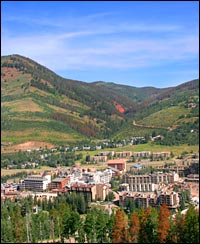Vail, Colo., is a town that’s defined by winter, when tourists from around the world descend on the area’s snow-covered slopes to ski, ride, and soak up the laid-back yet glitzy mountain lifestyle. But as the threat of global warming has begun to creep closer to the Colorado high country, Vail has been forced to develop another reputation, one based less on celebrity sightings and more on sustainable policy choices. Sure, it’s still a world-famous resort town with a past that’s less than green-friendly, but these days the area’s 4,500 year-round residents are on a mission to become one of the most environmentally progressive communities in the U.S.

Vail: cleaning its energy and its image.
Photo: iStockphoto
The latest step in this effort took place in August, when officials announced plans to offset all of the town’s municipal operations by buying wind power credits from a Boulder-based broker.
It’s a move that will, over the next three years, offset approximately 20 million kilowatt-hours of electricity and prevent 28 million pounds of carbon dioxide emissions. For those keeping score, excited town officials say that’s the equivalent of removing 2,681 cars from the road or planting 3,700 acres of mature trees. This year, costs for the $12,000 program will be paid out of the town’s supplemental budget, and, assuming it is approved by the town council in subsequent years, the expense will be rolled into the budget as part of normal energy expenditures.
The announcement — which followed closely on the heels of a similar move by the Vail Resorts ski company — was big news for Vail, which became the first municipality in the country to offset all of its energy use with wind power, but it was far from surprising. After all, daily life here is closely linked to the health and beauty of the natural world. No snow means no business — for everyone from ski operators to restaurateurs to booksellers — and as a result, local residents have a vested interest in promoting environmentally friendly policies.
“We believe that protecting Vail’s natural environment is critical to the health and prosperity of our community,” Town Manager Stan Zemler said in a statement announcing the plan. “Wind power is a simple step in continuously improving our environmental practices in the town.” He added that he hoped the town’s decision would stimulate interest in wind power from community members as well.
“We just got through with a community picketing process,” says Vail Environmental Health Officer Bill Carlson, who helped craft the town’s wind-power plan, “and the environment came up very strong among those who attended.” What issues are residents most concerned about? Developing a green-building code, controlling noise from nearby Interstate 70, dealing with a beetle problem that’s been killing thousands of trees in the area, and, in no uncertain terms, making sure their town becomes and remains “No. 1 in environmental leadership.”
Promoting the town’s commitment to renewable energy is a big part of that goal. More important, says Carlson, “it’s just the right thing to do.” In announcing the move, the town and its resort joined the Aspen Skiing Company and Whole Foods, both of which also began offsetting 100 percent of their power consumption with wind credits earlier this year. And since the announcement, a third Colorado ski operator, Triple Peaks LLC, which runs Crested Butte Mountain Resort, has also said it plans to purchase wind credits.
Carlson recently took some time out from his work to speak with Grist by phone about the future of wind power and Vail’s new shift toward civic environmentalism.
So, how did this wind-power project get started?
Actually, I had wanted to promote renewable energy for a long time. Vail Resorts was negotiating with a wind marketer in Boulder and several others around the country, so they were thinking about converting all their lift operations and mountain operations to wind energy. So, I thought, “You know, I think I’m going to investigate this for the town, too.”
What sorts of logistics were involved in making this happen?
I got four or five bids from various marketers. Two of them I thought were very good, and the ski company decided to pick one of them so we did as well. We ended up going with Renewable Choice Energy, out of Boulder, and that was just passed and approved by the council, so we have a three-year contract.
What about the economic cost?
You have to think of it in terms of the larger issues. I’m concerned, as the town’s environmental officer, with global warming — I think that’s the biggest, No. 1 environmental issue right now, and it impacts everything else. And of course we make our living here with snow for five to six months of the year. So I think it behooves the town to take a leadership role and to have strategies and actions that address greenhouse gases and do our part as a world-renowned resort community to be an example for that. Because at the rate we’re emitting carbon off into the atmosphere, we’re going to be in trouble in another 50 to 100 years.
Did you run into any opposition from the board?
No, we didn’t have any opposition. It was supported all along the way.
That’s amazing. Why do you think it struck a chord?
Well, I think the town is moving more toward an environmental sustainability policy, and renewable energy is one of those things that we just want to do. We’re already interested in increasing resource efficiency and reducing greenhouse gases, so I think you’re going to see the town be more environmentally conscious and have more strategies for stewardship actions in the future.

